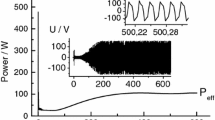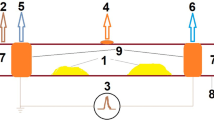Abstract
Most optical emission line intensities remain unchanged for a mercury HID plasma, exposed to coherent argon ion laser beam Innova 308 C (476.5 nm) in points far from electrodes. Small raise of Hg-546.08 nm line is due to photo-excitation of Ar+ ions, followed by excitation transfers through collision processes from excited (Ar+)* ions to Ar atoms, then from excited (Ar)* to Hg atoms. When the laser beam hits the electrode tip (photoelectric effect), the amount of electrons involved in plasma collisions increases: all characteristic emission spectral lines are intensifying. Electron temperature and concentration were also calculated. Differential Scanning Calorimetry performed in case of tungsten electrode with emissive material (Y2O3, BaCO3, CaCO3, WO3), linear and non-isothermally heated (0.17 K s-1) in flowing air, from 290.61 to 1603.72 K (platinum crucible), revealed both endothermic (CaCO3 and of BaCO3 decompositions) and exothermal (obtaining CaWO4, BaWO4 and Ba3WO6) processes. Thermogravimetry Analysis showed a mass decrease of 0.498%, in 290.61−505.15 K temperature range, due to water release. Oxidation of tungsten electrode causes a significant mass increase of 17.292% in 809.15−1183.15 K range. BaWO4, Ba3WO6 and WO3 sublimations gave a mass fall of 6.757% in 1513.15−1603.72 K range. No thermal effects were recorded on heating in argon atmosphere, from 446.15 to 1596.15 K, in alumina crucible.
















Similar content being viewed by others
References
Van de Sanden MCM, Janssen GM, De Regt JM, Schram DC, Van der Mullen JAM, Van der Sijde B. The distribution pattern of the electron density and the electron temperature in a weakly compressible argon plasma jet measured by a Langmuir triple probe. Rev Sci Instrum. 1992;63(6):3369–77.
Hutchinson IH. Principles of plasma diagnostics. Cambridge: Cambridge University Press; 1987.
Ed Auciello O, and Flamm DL (1989). Plasma Diagnostics, volume 1: discharge parameters and chemistry. Academic Press. Boston.
Meulenbroeks RFG, Steenbakkers MFM, Qing Z, Van de Sanden MCM, Schram DC. Four ways to determine the electron density in low-temperature plasmas. Phys Rev E. 1994;49:2272–5.
Poissant G, Dudeck M. Velocity profiles in a rarefied argon plasma stream by crossed electrostatic probe. J Appl Phys. 1985;58(5):1772–9.
Kelkar M, Heberlein J. Wire-arc spray modeling. J Plasma Chem Plasma Process. 2002;22(1):1–25.
Rat V, André P, Aubreton J, Elchinger MF, Fauchais P, Lefort A. Transport properties in a two-temperature plasma: theory and application. Phys Rev E. 2001;64(2): 026409.
Boulos MI, Fauchais P, Pfender E. Thermal plasmas: fundamentals and applications. Springer; 1994.
Fridman A, Cho YI. Transport phenomena in plasma. Elsevier: Academic Press; 2007.
Cristea M, Zissis G. Thin barium layer formation and its influence on tungsten electrode arc attachment modes in HID lamps. J Optoelectron Adv Mater. 2003;5(2):511–20.
Waymouth JF. Overview in radiative processes in discharge plasmas. New York: Plenum; 1986.
Van de Sande MJ. Laser scattering on low temperature plasmas-high resolution and stray light rejection. Eindhoven: Eindhoven Technische Universiteit; 2002.
Hidaka R, Ooki T, Takeda K, Kondo K, Kanada H, Uchino K, Matsuda Y, Muraoka K, Ruby AM. Laser scattering diagnostics of a supersonic plasma flow for low-pressure plasma spraying. Jpn J Appl Phys. 1987;26(10):1724–6.
Ravary B, Fulcheri L, Bakken JA, Flamant G, Fabry F. Influence of the electromagnetic forces on momentum and heat transfer in a 3-phase ac plasma reactor. Plasma Chem Plasma Process. 1999;19(1):69–89.
Carbone E, Nijdam S. Thomson scattering on non-equilibrium low density plasmas: principles, practice and challenges. Plasma Phys Control Fusion. 2015;57(1): 014026.
Garcia MC, Varo M, Martinez P. Excitation of species in an expanded argon microwave plasma at atmospheric pressure. Plasma Chem Plasma Process. 2010;30:241–55.
Benilov MS. Understanding and modeling plasma-electrode interaction in high pressure arc discharges: a review. J Phys D Appl Phys. 2008;41: 144001.
Chen WLT, Oerlein J, Pfender E, Pateyron B, Delluc G, Elchinger MF, Fauchais P. Thermodynamic and transport properties of argon/helium plasmas at atmospheric pressure. Plasma Chem Plasma Process. 1995;15(3):559–79.
Zissis G, Benetruy P, Bernat I. Modeling the Hg-Ar low-pressure-discharge positive column: a comparative study. Phys Rev A. 1992;45(2):1135–48.
Zhou J, Pérez-Grande D, Fajardo P, Ahedo E. Numerical treatment of a magnetized electron fluid model within an electromagnetic plasma thruster simulation code. Plasma Sources Sci Technol. 2019;28(1):11504.
Burm KTAL. The fourth state of matter. Plasma Chem Plasma Process. 2012;32:401–7.
Mostaghimi J, Boulos MI. Two-dimensional electromagnetic field effects in induction plasma modeling. Plasma Chem Plasma Process. 1989;9(1):25–44.
Harabor NA, Harabor A, Palarie I, Popescu IM, Zissis G. Time Evolution of Optical Emission Spectrum of a Hg-HID Lamp Exposed to X-ray. Plasma Chem Plasma Process. 2010;30:449–59.
Harabor NA, Harabor A, Popescu IM. Transient Emission Spectra of a High Pressure Hg Lamp Exposed to X-Ray. UPB Sci Bull Series A. 2011;73(3):173–84.
Harabor A, Rotaru P, Harabor NA. Thermal and spectral behaviour of (Y, Eu)VO4 powder. J Therm Anal Calorim. 2013;111:1211–9.
Van Gessel AFH, Carbone EAD, Bruggeman PJ, Van der Mullen JJAM. Laser scattering on an atmospheric pressure plasma jet: disentangling Rayleigh, Raman and Thomson scattering. Plasma Sources Sci Technol. 2012;21:015003–11.
Jonkers J. Excitation and transport in small scale plasmas. Ph.D. thesis: Eindhoven University of Technology. www.wikipedia.org/wiki/Work function. Accessed 21 Jun 2014
Kramida A, Ralchenko Yu, Reader J and NIST Atomic spectra database (version 5.1) [Online] Available: http://physics.nist.gov/asd. National Institute of Standards and Technology, Gaithersburg, MD; 2014, February 13.
Mishra KC, Garner R, Schmidt PC. Model of work function of tungsten cathodes with barium oxide coating. J Appl Phys. 2004;95(6):3069–74.
Bakker LP, Kroesen GMW. Thomson scattering in a low-pressure argon mercury positive column. J Appl Phys. 2000;88(2):3899–904.
Forman R. Surface studies of barium and barium oxide on tungsten and its application to understanding the mechanism of operation of an impregnated tungsten cathode. J Appl Phys. 1976;47:5272–9.
Penney CM, St PRL, Lapp M. Absolute rotational Raman cross sections for N2, O2, and CO2. J Opt Soc Am. 1974;64(5):712–6.
Fenner W, Hyatt HA, Kellam JM, Porto SPS. Raman cross section of some simple gases. J Opt Soc Am. 1973;63(1):73–7.
Hyatt HA, Cherlow JM, Fenner WR, Porto SPS. Cross section for the Raman effect in molecular nitrogen gas. J Opt Soc Am. 1973;63(12):1504–6.
Belmonte T, Noël C, Gries T, Martin J, Henrion G. Theoretical background of optical emission spectroscopy for analysis of atmospheric pressure plasmas. Plasma Sources Sci Technol. 2015;24: 064003.
Harabor NA and Harabor (2015). A. Light Sources: HID Lamps. Universitaria Publishing Houss, Craiova,
Harabor NA, Harabor A, Rotaru P. Transient Hg, Ba+, Ca+ and Y+ optical emission lines of a mercury hid lamp exposed to x-ray: thermal analysis of the tungsten electrode with emissive mixture based on barium, calcium and yttrium. Plasma Chem Plasma Process. 2017;37(1):305–23.
Cristea M, Zissis G. Thin barium layer formation and its influence on tungsten electrode arc attachment modes in HID lamps. J Optoelectron Adv Mater. 2007;5(2):511–20.
Beck I, Josepovits VK, Sneider J, Toth Z. Investigation of electron emission properties of Ba-activated tungsten cathodes. J Phys D Appl Phys. 2005;38(27):3865.
Bhalla S Ranbir (1979). US Patent 4152619 A HID lamp electrode comprising barium (yttrium or rare earth metal) tungstate or molybdate. Westinghouse Electric Corp, USA
De Kok Johannis () (1977). Brevet US 4052634. U.S. Philips Corporation (Current U.S. class: 313/184; 313/213; 313/218; 313/229; Cathodes coated with emissive materials): New York
Zalach J, Araoud Z, Charrada K, Franke S, Schoepp H, Zissis G. Experimental and theoretical investigations on the warm-up of a high-pressure mercury discharge lamp. Phys Plasmas. 2011;18(3):033511–9.
Karunadasaa K, Manoratnea CH, Pitawalab HMTGA, Rajapaksec RMG. Thermal decomposition of calcium carbonate (calcite polymorph) as examined by in-situ high-temperature X-ray powder diffraction. J Phys Chem Solids. 2019;134:21–8.
Galan I, Glasser FP, Andrade C. Calcium carbonate decomposition. J Therm Anal Calorim. 2013;111:1197–202.
Arvanitidis I, Sichen Du, Seetharaman S. A Study of the thermal decomposition of BaCO3. Metall and Mater Trans B. 1996;27B:409–16.
Hackspill L, Wolfe G. Compt Rend. 1937;204:1820–2.
Baker EH. The barium oxide–carbon dioxide system in the pressure range 0.01–450 atmospheres. J Chem Soc. 1964;1:699–704s.
Dong J, Li J, Zhu F, Li Z, Farawi R. Melting curve minimum of barium carbonate BaCO3 near 5 Gpa. Am Miner. 2019;104:671–8.
Popovič A, Bencze L, Marsel J, Lesar A, Vass-Balthazar K, Kaposi O. Rap Comm Mass Spect. 1993;7(6):416.
Higashi C, de Lima NB, Matos JR, Giovedi C, Motta CC (2005). Electron emitting barium-calcium aluminate obtained from chemical solution techniques. Proceedings of the SBMO/IEEE MTT-S International Conference on Microwave and Optoelectronics. Brasilia, Brazil
Hughes RC, Coppola PP, Evans HT, Hughes RC, Coppola PP, Evans HT. Chemical reactions in barium oxide on tungsten emitters. J Appl Phys. 1952;23(6):635–41.
Cristea M (2008). Nonlinearities in electrodes-plasma interaction in high pressure mercury vapors electrical discharge. PRINTECH: Bucharest.
Patnaik P (2003). Handbook of inorganic chemical compounds. McGraw-Hill: New York, Chicago San Francisco, Lisbon, London, Madrid, Mexico City, Milan, New Delhi
Gromov A, Kwon YS, Choi PP. Interaction of tungsten nanopowders with air under different conditions. Scripta Mater. 2005;52(5):375–80.
Flor G, Massarotti V, Riccardi R. On the mechanism of CaWO3 formation in the Solid State from CaO and WO3. Z Naturforsch A. 1977;32(2):160–2.
Christov SG, Vodenicharov CM. On the experimental proof of the general theory of electron emission from metal. Solid State Electron. 1968;11(8):757–66.
Waymouth JF (1971). Electric discharge lamps: monograph in modern electrical technology. MA: MIT Press: Cambridge
Ingraham TR, Marier P. Kinetics studies on the thermal decomposition of calcium carbonate. Canad J Chem Eng. 1963;41:170–3.
Zheng J, Huang J, Tao L, Li Z, Wang Q. A multifaceted kinetic model for the thermal decomposition of calcium carbonate. Crystals. 2020;10(9):849.
Rotaru A, Schiemer J, Carpenter M. Elastic and inelastic relaxations accompanying relaxor dielectric behaviour of Ba6GaNb9O30 tetragonal tungsten bronze from resonant ultrasound spectroscopy. J Therm Anal Calorim. 2016;124(2):571–83.
Lvov BL, Ugolkov VL. Peculiarities of CaCO3, SrCO3 and BaCO3 decomposition in CO2 as a proof of their primary dissociative evaporation. Thermochim Acta. 2004;410:45–55.
Harabor A, Rotaru P, Harabor NA, Nozar P, Rotaru A. Orthorhombic YBCO-123 ceramic oxide superconductor: structural, resistive and thermal properties. Ceram Int. 2019;45(2):2899–907.
Harabor A, Rotaru P, Harabor NA, Nozar P, Rotaru A. Structural, thermal and superconducting properties of Ag2O-doped YBa2Cu3O7-x composite materials. Ceram Int. 2023;49(9):14904–16.
Han BY, Khoroshilov A, Tyurin AV, Baranchikov AE, Razumov MI, Ivanova OS, Gavrichev KS, Ivanov VK. WO3 thermodynamic properties at 80–1256 K revisited. J Therm Anal Calorim. 2020;142:1533–43.
Asim N, Syuhami MF, Badei M, Yarmo MA. WO3 modification by synthesis of nanocomposites. APCBEE Proc. 2014;9:175–80.
Szilágyi IM, Kállay-Menyhárd A, Šulcová P, Kristóf J, Pielichowski K, Šimon P. Recent advances in thermal analysis and calorimetry presented at the 1st journal of thermal analysis and calorimetry conference and 6th v4 (joint czech-hungarian-polish-slovakian) thermoanalytical conference (2017). J Therm Anal Calorim. 2018;133:1–4.
McNulty J, Pesquera D, Gardner J, Rotaru A, Playford H, Tucker M, Carpenter M, Morrison F. Local structure and order-disorder transitions in “empty” ferroelectric tetragonal tungsten bronzes. Chem Mater. 2020;32(19):8492–501.
Author information
Authors and Affiliations
Corresponding author
Additional information
Publisher's Note
Springer Nature remains neutral with regard to jurisdictional claims in published maps and institutional affiliations.
Rights and permissions
Springer Nature or its licensor (e.g. a society or other partner) holds exclusive rights to this article under a publishing agreement with the author(s) or other rightsholder(s); author self-archiving of the accepted manuscript version of this article is solely governed by the terms of such publishing agreement and applicable law.
About this article
Cite this article
Harabor, NA., Harabor, A., Rotaru, P. et al. High pressure mercury AC discharge tube exposed to coherent laser: optical, electrical and thermal aspects. J Therm Anal Calorim 148, 10515–10529 (2023). https://doi.org/10.1007/s10973-023-12380-1
Received:
Accepted:
Published:
Issue Date:
DOI: https://doi.org/10.1007/s10973-023-12380-1




